Actuators control elements within an HVAC system, such as dampers, valves, and fans. They convert a control signal into mechanical action, often receiving alerts from a thermostat or other control system. Depending on the signal, the actuator will adjust the position of a damper, open or close a valve, or control a fan's speed.
The Importance of Actuators in HVAC Systems
Actuators play a vital role in temperature control within a space, adjusting dampers and valves to maintain the desired levels. By managing the ventilation rates, they also control humidity levels and help maintain good indoor air quality. This precise control over heating, cooling, and airflow adds to the overall comfort within an area, avoiding zones that are too hot, cold, or drafty.
Actuators also make a significant impact on energy efficiency. By responding accurately to control signals, they ensure that HVAC systems only work as hard as they need to, reducing unnecessary energy consumption and lowering costs and environmental impact.
In modern buildings where the HVAC system is often part of a broader building automation system, actuators facilitate communication and cooperation with other building functions such as lighting and security. Some actuators are designed to fail-safe in a particular position if they lose their control signal, an essential safety feature that ensures critical functions, like fire dampers, are in the proper position in case of system failure.
What is Valve Actuation?
Valve actuation is the process of controlling or manipulating valves using actuators. These valves regulate the flow of air, water, or other fluids within a system, influencing factors like temperature, humidity, and overall climate control.
Actuators can be electric, pneumatic, hydraulic, or even manual, and they convert various forms of energy into mechanical motion to open, close, or modulate the valve. This action can be binary (fully open or closed), proportional (partially open depending on a control signal), or include safety features like spring return mechanisms for fail-safe operation.
Valve actuation plays a crucial role in the efficient operation of HVAC systems. By precisely controlling the flow of heating or cooling media, valve actuators help to maintain the desired environmental conditions within a building or space. They allow for automated or remote control, integrating with building management systems for optimal energy efficiency, comfort, and safety.
Types of Actuators
Electric Actuators
Electric actuators use electrical energy to control or adjust elements within an HVAC system, such as dampers, valves, or vents. These actuators can open, close, or modulate components by converting electrical signals into mechanical motion to regulate airflow, temperature, or humidity. Electric actuators offer precise control and can be easily integrated with thermostats and building management systems, allowing for automated and energy-efficient climate control. There are several different types of electric actuators, including:
Linear Electric Actuators
Used to create straight-line motion, these actuators may control dampers or valves to regulate airflow or fluid flow within the system. By applying voltage to an electric motor within the actuator, the motor turns, and through a series of gears or other transmission mechanisms, this rotational motion is converted into linear movement. This allows for precise control of the position of the connected component, enabling accurate regulation of fluid flow or air distribution within the HVAC system.

Rotary Electric Actuators
These actuators provide rotational motion and are often employed to turn components such as dampers or valves, precisely controlling air or coolant flow. When voltage is applied to the electric motor inside the actuator, it generates a rotational force, which can be transmitted through gears or other mechanisms to rotate the connected component. This rotation enables control over the flow of air, water, or other fluids within an HVAC system by adjusting the position of the valves or dampers.

Multi-Turn Electric Actuators
Multi-turn electric actuators are specialized devices that provide multiple shaft rotations, allowing for intricate control over applications like gate or globe valves within HVAC systems. They convert electrical energy into rotational movement through an electric motor and a series of gears or transmission mechanisms, enabling the connected component to rotate multiple times. This multi-turn capability ensures precise fluid flow regulation, permitting the fine-tuning necessary for specific control requirements within heating, ventilation, or air conditioning systems. Multi-turn electric actuators are valued for their accuracy and flexibility, enabling complex control in various HVAC applications.

Modulating Electric Actuators
Modulating electric actuators are devices designed to control the flow of air, water, or other fluids by continuously adjusting the position of a valve, damper, or other control element within HVAC systems. Unlike simple on/off actuators, they receive a continuous signal that dictates the exact position of the controlled element, allowing for finer and more responsive adjustments. This modulating action enables precise control over the HVAC system's temperature, pressure, or flow rate, optimizing energy efficiency and system performance. Modulating electric actuators are particularly valued in applications that require a high degree of control and adaptability, making them a key component in many modern HVAC systems.
Spring Return Electric Actuators
A spring return electric actuator utilizes an electric motor with a mechanical spring to control a component, such as a valve or a damper, within HVAC systems. In typical operation, the electric motor drives the actuator to the desired position, overcoming the tension of the spring. If power is lost or a signal is sent to revert the actuator to its default position, the spring's stored energy is released, causing it to return to its predetermined "fail-safe" position. This design enhances safety and reliability, especially in critical applications, ensuring that the system reverts to a safe state in case of a power failure or other operational anomalies.
Electrohydraulic Actuators
An electrohydraulic actuator combines the principles of electrical and hydraulic systems to provide precise control in various applications, including HVAC systems. It typically consists of an electric motor that drives a hydraulic pump, generating pressure to move pistons or other hydraulic mechanisms. The hydraulic system offers high force capabilities, while the electric motor provides the control needed to position components like valves or dampers accurately. This blending of electric and hydraulic technologies enables highly responsive and powerful control, making the electrohydraulic actuator suitable for demanding applications. Electrohydraulic actuators can be used to manage large dampers or valves, providing reliable and energy-efficient control of temperature, airflow, or fluid distribution within a building or facility.
Pneumatic Actuators
Pneumatic actuators use compressed air to create motion, and several different types are utilized depending on the system's specific requirements. Here's a look at some common types of pneumatic actuators used in HVAC:
Linear Pneumatic Actuators
Linear pneumatic actuators use compressed air to generate linear motion, typically to control components such as valves or dampers within HVAC systems. The compressed air acts on a piston within a cylindrical chamber, pushing it in a straight line. The linear movement of the piston is then transmitted to the connected component, allowing for precise control of the position of valves or dampers. This linear motion enables accurate fluid or air flow regulation within the HVAC system.

Rotary Pneumatic Actuators
Rotary pneumatic actuators use compressed air to generate rotational motion, commonly employed to control elements like valves or dampers in HVAC systems. The compressed air is directed to a chamber where it acts on a vane or piston, converting the linear force of the compressed air into rotational movement. This rotational force is used to turn a connected component, such as a valve, to regulate the flow of air, water, or other fluids within the HVAC system.

Spring Return (or Single-Acting) Pneumatic Actuators
Spring return, or single-acting pneumatic actuators, use compressed air in conjunction with a mechanical spring to control components within HVAC systems. When applied, compressed air moves a piston or vane, causing the actuator to rotate or move linearly to a specific position. When the air pressure is released, a preloaded spring forces the actuator to return to its original position, providing a "fail-safe" function. This design ensures that the system reverts to a predetermined safe state in the event of a loss of air pressure. Spring return pneumatic actuators are commonly used in HVAC applications to control valves or dampers, offering both precise control and enhanced safety.
Double-Acting Pneumatic Actuators
Double-acting pneumatic actuators use compressed air to control motion in both directions, typically used to actuate components like valves or dampers in HVAC systems. Unlike single-acting actuators, which use a spring to return to the original position, double-acting actuators use compressed air on both sides of a piston or vane. By controlling the distribution of air pressure between the chambers, the actuator can be driven in both directions, allowing for more complex and nuanced control. This bidirectional control offers increased precision and flexibility, enabling more sophisticated HVAC control strategies. Double-acting pneumatic actuators are popular in applications requiring precise and continuous regulation of airflow or fluid flow, contributing to efficient operation and optimal climate control within a building or facility.

Proportional Pneumatic Actuators
Proportional pneumatic actuators use compressed air to provide variable, or proportional, control over a mechanical component, such as a valve or damper, within HVAC systems. Unlike simple on-off actuators, proportional actuators allow continuous adjustment within a specified range. The input signal (usually electrical) is translated into a corresponding air pressure level, causing the actuator to move to a position proportional to the signal. This enables fine-tuned control of air, water, or other fluids within the HVAC system. Proportional pneumatic actuators are commonly used in applications requiring precise temperature, humidity, or airflow control.
Diaphragm Actuators
Utilizing a flexible diaphragm, these actuators convert pneumatic pressure into mechanical motion. They are often used to control valves in HVAC systems. The diaphragm, typically made of a flexible material such as rubber or elastomer, is positioned between two chambers. By altering the pressure in one of the chambers, the diaphragm deforms, translating the pressure change into linear or rotational motion. This movement can then be used to regulate the position of a valve or other connected components. Diaphragm actuators are appreciated for their sensitivity, smooth operation, and ability to create a hermetic separation between the driving fluid (such as air) and the controlled medium.

Piston Actuators
Piston actuators use a piston within a cylindrical chamber to convert energy into linear or rotational motion. These actuators are suitable for applications requiring higher force and can be used to control larger valves or dampers. The energy, often compressed air or hydraulic fluid, pushes against the piston, causing it to move within the cylinder. This movement is then transferred to the connected component, such as a valve stem, to control the flow of air, water, or other fluids within the HVAC system.
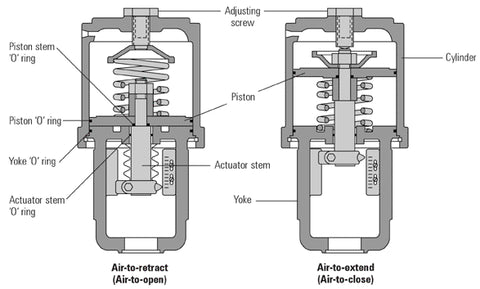
Rack & Pinion Actuators
Rack and pinion actuators translate linear motion into rotational motion, commonly used in HVAC systems to control rotary valves or dampers. The actuator consists of a linear gear (rack) that meshes with a circular gear (pinion). When the rack moves linearly, due to a force often supplied by compressed air, hydraulic fluid, or an electric motor, it causes the pinion to rotate. This rotational motion is then used to control the position of the connected valve or damper, allowing for precise regulation of fluid or air flow within the HVAC system.

Thermal Actuators
Thermal actuators are commonly used in HVAC applications, particularly in systems that require precise temperature control. One prominent use is in Thermostatic Radiator Valves (TRVs), where thermal actuators control the flow of hot water to regulate room temperature. When the temperature in the room reaches a preset level, the actuator contracts or expands to adjust the valve. They are also frequently used in underfloor heating systems to control the flow of heated water, allowing for precise temperature control in different zones.
Energy efficiency is another advantage of thermal actuators; they respond directly to temperature changes and operate without electrical power, making them attractive in systems that minimize energy consumption. In some cases, thermal actuators may be chosen for their cost-effectiveness, especially in applications that do not require rapid response times.
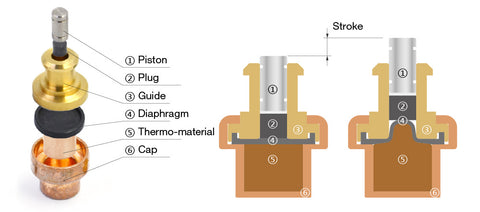
Some thermal actuators utilize wax motors that expand and contract with temperature changes, which are used in various HVAC applications to control the flow of fluids. Additionally, some HVAC controls incorporate bimetallic elements that bend with temperature changes to actuate switches or valves, representing another form of thermal actuation.
Hydraulic Actuators
Hydraulic actuators use hydraulic fluid to create motion. They are known for their high force and torque capabilities, making them suitable for heavy-duty applications such as controlling large dampers or valves. These actuators tend to be more complex, requiring a hydraulic power unit to function, and are less commonly used in HVAC systems than electric or pneumatic actuators.
Their application is typically more specialized, often found in large-scale or industrial systems, high-torque applications, extreme environmental conditions, or systems with pre-existing hydraulic infrastructure. While they offer advantages in strength and reliability, the need for hydraulic infrastructure, potential for fluid leaks, maintenance requirements, and energy efficiency considerations may limit their use in standard HVAC applications.
Manual Actuators
Manual actuators, operated by hand through simple levers or hand wheels, are often used in HVAC applications where automatic control is not required or as a backup means of control. Especially common in smaller commercial or residential HVAC systems, they offer simplicity and cost-efficiency, allowing for the manual operation of valves, dampers, or other components. They are also employed for quick response needs, such as emergency shut-off valves that must be rapidly closed due to a malfunction or safety concern. Serving as a budget-friendly alternative, manual actuators can be installed alongside automated systems for backup control or redundancy. They may also be preferred in specialized situations, such as parts of the HVAC system requiring periodic maintenance or servicing. They allow technicians to isolate sections of the system easily and are still found in older HVAC systems lacking modern automated controls. Manual actuators are valued for their flexibility and reliability across various HVAC contexts.
HVAC Actuator FAQs
How do electric actuators differ from pneumatic actuators?
Electric actuators use electric motors to create motion, while pneumatic actuators use compressed air. Electric actuators typically offer more precise control, while pneumatic actuators might be more energy-efficient in some applications.
Why would an actuator fail?
An actuator failure in an HVAC system can occur for various reasons, often due to a combination of factors related to design, environment, operation, or maintenance. Here are some common causes:
- Wear & Tear: Actuators contain moving parts that can wear out over time. Regular usage and the constant motion of opening and closing valves or dampers can lead to degradation and eventual failure.
- Improper Installation: If an actuator is not installed correctly, it may be subjected to stresses and loads it was not designed to handle, leading to premature failure.
- Environmental Factors: Exposure to extreme temperatures, moisture, dust, or corrosive substances can affect an actuator's performance and lifespan. The materials used in construction must be suitable for the intended environment to avoid these issues.
- Electrical Failures: Electric actuators rely on electrical components that may fail due to voltage spikes, short circuits, or wiring problems. These can lead to a loss of control and eventual failure of the actuator.
- Lack of Maintenance: Regular maintenance is essential to keep actuators in good working condition. Failure to properly lubricate, clean, and inspect actuators can lead to mechanical failures and reduced lifespan.
- Hydraulic or Pneumatic Issues: Hydraulic and pneumatic actuators rely on fluids or air pressure to function. Leaks, contamination, or pressure issues can cause actuator malfunctions.
- Incompatible Components: If an actuator is used with incompatible valves, dampers, or other HVAC components, it might not function as intended, leading to premature failure.
- Poor Quality or Defective Components: Actuators built with substandard or defective materials may perform differently than expected and be prone to failure.
- Overloading: Subjecting an actuator to forces or demands beyond its specified limits can cause mechanical failure. Ensuring the actuator is appropriately sized for its application is crucial to avoid overloading.
- Improper Operation: If the actuator is used in a manner not aligned with its design or the manufacturer's instructions, it can lead to failure. This includes manual override of automatic controls or incorrect settings.
- Software or Control Failures: Modern actuators often include electronic controls that can fail due to software bugs, incorrect configuration, or other issues related to the control system.
- Aging: Like all mechanical devices, actuators have a finite lifespan. Even with proper care and maintenance, they will eventually reach the end of their service life.
What is a damper actuator, and how does it work?
A damper actuator controls the opening and closing of dampers in an HVAC system. Adjusting the dampers regulates airflow within ducts, contributing to temperature and air quality control.
Are manual actuators still used in modern HVAC systems?
Yes, manual actuators are still used, especially where cost-efficiency, simplicity, or manual control is needed. They can be found in emergency shut-off valves, backup systems, or in certain maintenance or specialized control situations.
How do I choose the right actuator for my HVAC system?
Choosing the right actuator for your HVAC system is crucial in ensuring optimal performance and efficiency. Here's a guide to help you make the right decision:
- Understand Your System Requirements: Determine the specific needs of your HVAC system. What kind of control do you need over the temperature, airflow, humidity, etc.? This will help you identify the type of actuator that best suits your needs.
- Identify the Type of Actuator: HVAC actuators can be electric, pneumatic, hydraulic, manual, or a combination. Understanding the advantages and limitations of each type can help you select the one that fits your application. For example, electric actuators might be chosen for precise control, while pneumatic actuators might be more energy-efficient in specific scenarios.
- Consider the Application: Where and how will the actuator be used? If it's for an emergency shut-off valve, consider a manual actuator. You might need an actuator that offers more precise adjustments for zoning control.
- Evaluate Energy Efficiency: If energy efficiency is a priority, consider actuators that provide precise control without consuming excessive power. This might influence your choice between electric and pneumatic actuators.
- Check Compatibility: Ensure the actuator is compatible with other components in your HVAC system, such as valves, dampers, or controllers.
- Consider Environmental Conditions: If the HVAC system operates in extreme temperatures, moisture, or other harsh conditions, choose an actuator designed to withstand these environments.
- Assess Cost: Balance the cost of the actuator with its functionality and quality. Spending more on a higher-quality actuator can save money in the long run through improved performance and reduced maintenance needs.
- Consult a Professional: If you are unsure, consult an HVAC professional or technician with experience with your specific system type and needs. They can provide valuable insights and recommendations based on your unique situation.
- Review Maintenance Needs: Consider the maintenance requirements of the actuator. Some may need more frequent servicing or specialized care, impacting long-term costs and reliability.
- Evaluate Warranty and Support: Check the warranty and support options for the actuator. Knowing that you have support if something goes wrong can be reassuring.
- Consider Future Needs: Consider potential changes or expansions to your HVAC system. Choosing an actuator that can accommodate future needs might save time and money later.
By carefully assessing these factors and consulting with an HVAC professional, you can choose the suitable actuator for your HVAC system, ensuring that it operates efficiently and fulfills your specific requirements.
Can actuators help in energy efficiency?
Absolutely, actuators that provide precise control and function properly can enhance energy efficiency by ensuring that the HVAC system operates at optimal levels, thereby minimizing energy waste.
What is the lifespan of actuators in HVAC systems?
The lifespan of an HVAC actuator can vary based on the type, quality, usage, and maintenance. Regular inspection and proper care can extend the life of actuators, and they may typically last several years.
Actuators by Manufacturer
Johnson Controls Actuators
Valves and actuators are essential components in a complete system, and their effectiveness is crucial. Johnson Controls provides various valve and actuator combinations for reliable and long-lasting performance.
Learn more about Johnson Controls actuators on YouTube:
Or watch the Actuators & Valves playlist:
Shop Johnson Controls Actuators
Honeywell Actuators
Honeywell Linear Actuators
Honeywell linear actuators create motion in a straight line and are used in various industrial and commercial applications. They can be powered by electric, hydraulic, or pneumatic means and are designed to meet specific requirements such as force, speed, and environmental resistance.

Shop Honeywell Pneumatic Linear Actuators
Honeywell Rotary Actuators
Honeywell rotary actuators convert energy into rotational motion and are utilized in various industrial, aerospace, and commercial applications. They can be electric, hydraulic, or pneumatic and are designed to meet specific torque and speed requirements. Known for their precision and reliability, Honeywell's rotary actuators are integral components in systems requiring controlled turning or twisting movements.
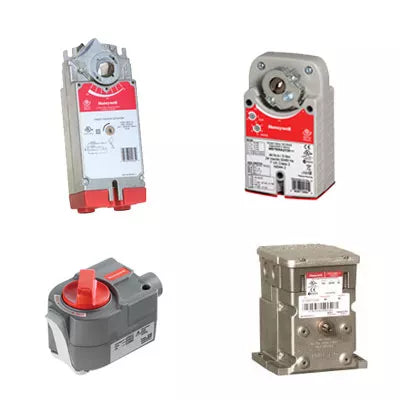
Shop Honeywell Rotary Actuators
Daikin Actuators
Daikin electromechanical actuators manage HVAC systems' valve and damper operations. They help automate systems, thus ensuring efficient energy use, improved safety, and optimal thermal comfort. Available in various models to suit multiple HVAC configurations, these actuators are renowned for their durable construction, long service life, and smooth performance.

Lennox Actuators
Lennox actuators automate the operations of valves and dampers. They are designed to regulate thermal comfort and energy usage in various environments and offer a blend of robust construction and efficiency.

Carrier Actuators
Carrier actuators are crucial components used in HVAC systems. These actuators enable precise control over the system's air, water, or other fluid flow. They regulate temperature, humidity, and airflow, ensuring optimal comfort and energy efficiency.
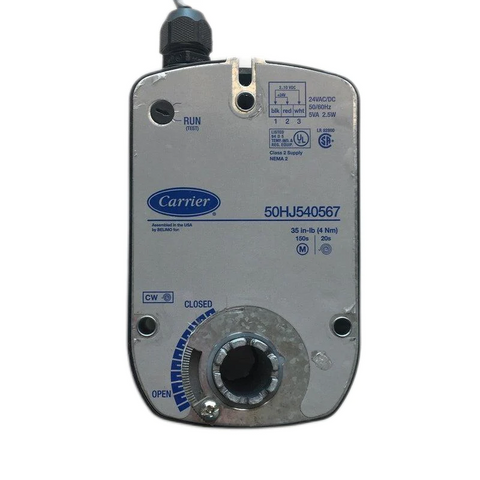
Trane Actuators
Trane actuators are responsible for automating control functions such as the operation of valves and dampers—their robust design and efficiency aid in managing energy use and enhancing thermal comfort in various settings.
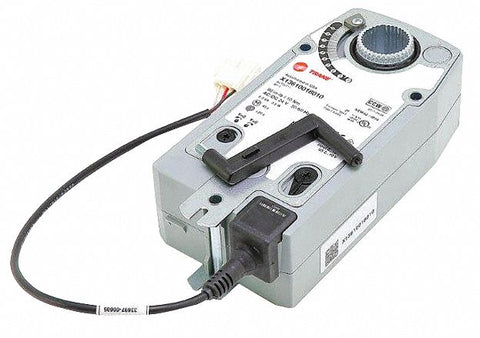
AAON Actuators
AAON actuators control the flow of air, water, or other fluids and offer precise and reliable operation, enabling efficient regulation of various system parameters.
York Actuators
York actuators are responsible for the automation of valves and dampers. Renowned for their sturdy design and operational efficiency, they are critical in controlling energy utilization and maintaining ideal thermal conditions.
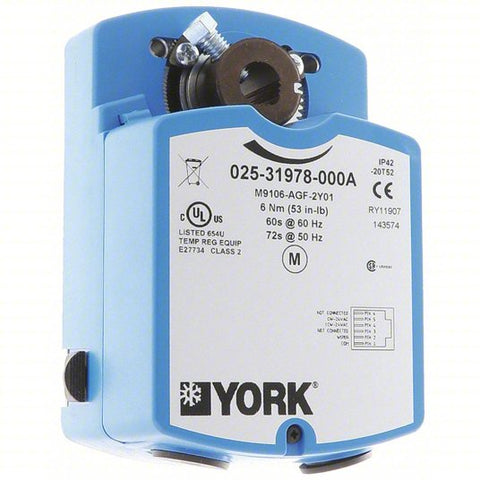
NIBCO Valve Actuation
NIBCO's actuator offerings encompass electric and pneumatic types designed to control the flow of liquids or gases through valves in various industrial and commercial applications. Known for quality and durability, NIBCO's actuators are suitable for different environments and come in multiple configurations to meet specific operational requirements. From water treatment to chemical processing, NIBCO's actuators offer a range of solutions that can be tailored to different industry needs.


